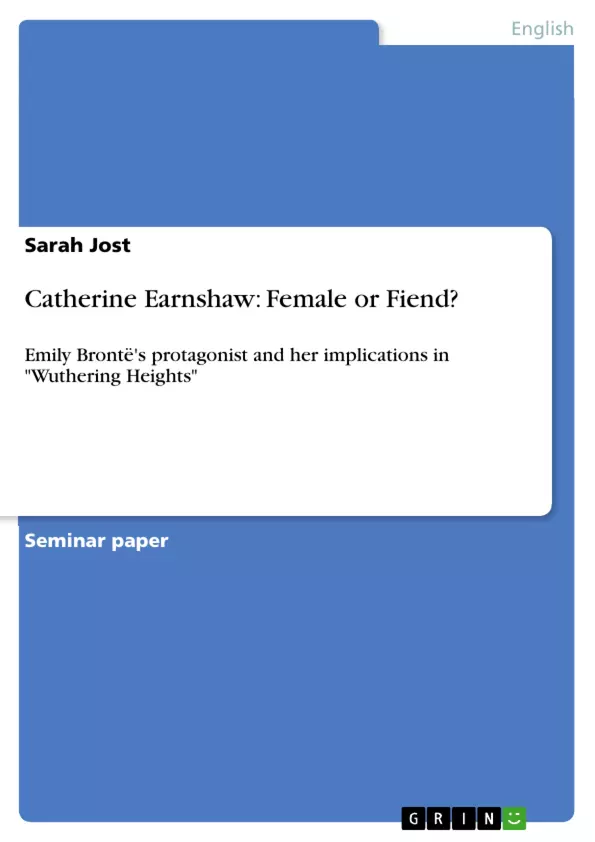The character of Catherine Earnshaw is one of the most complex and fascinating in world literature. Her story is that of a young woman who “betrays her deepest self and so destroys herself” but whose love is so strong that not even death can extinguish it. Readers cannot help but be moved by her fate, even though she appears to be a thoroughly unpleasant person in more than just one respect. They are forced to pity her, even though they feel they have every reason to believe that it is her, and her alone, who is to blame for the misery that befalls her. And, worst of all, they see her suffering and dying, but at the same time they cannot help envying her ability to feel as strongly as she does.
These confusing and seemingly contradictory impressions have led many critics of the novel to describe Catherine using terms like “creature of another species, hysterical, savage or demonic” out of a sheer inability to make anything else of her, anything that they could understand. In this paper, I shall attempt to determine whether these “otherwordly” terms that reek of madness and hell are really necessary or whether it might not be possible to do without them and see Catherine simply as a young woman in a very 18th/19th-century dilemma, a girl who marries the wrong man and ends up heartbroken.
I will begin by attempting a characterization of Catherine and then introducing her author, Emily Brontë, to have a closer look at the world and the mind that Catherine is rooted in.
Finally I will try to discover the true nature of Catherine’s dilemma and whether all these aspects will make it possible to demystify Catherine and return her to the state of a human being.
Table of Contents
- Introduction
- Catherine
- Catherine
- Catherine and Emily
- Catherine and Gondal
- Catherine and Emily
- Catherine's Dilemma
- Conclusion
Objectives and Key Themes
This paper aims to analyze the complex character of Catherine Earnshaw in Emily Brontë's *Wuthering Heights*, attempting to understand her motivations and the implications of her actions. The paper explores the ways in which Catherine's upbringing and environment contribute to her multifaceted personality and ultimately her tragic fate.
- Catherine's upbringing in a wild, natural environment and its impact on her character.
- The conflict between Catherine's desire for social advancement and her passionate love for Heathcliff.
- The consequences of Catherine's choices, particularly her marriage to Edgar Linton, on both herself and those around her.
- The dual nature of Catherine, manifested in her behavior towards Edgar and Heathcliff.
- The role of gender and societal expectations in shaping Catherine's life and choices.
Chapter Summaries
The paper begins by introducing Catherine Earnshaw, a young woman whose story is both captivating and perplexing. Her upbringing in a wild, natural environment, devoid of strong parental figures, shapes her into a wild and instinctive being. This chapter delves into Catherine's character, exploring her dominating nature, her relationship with Heathcliff, and the consequences of her choice to marry Edgar Linton. It explores the tragic consequences of her actions on both herself and those around her.
The paper then examines the complex relationship between Catherine and Emily Brontë. This section explores the possible influence of Brontë's own life and writing on the creation of Catherine. It also discusses the potential connection between Catherine and Emily's fictional world, Gondal.
The final chapter before the conclusion dives deep into Catherine's inner turmoil and the nature of her dilemma. It explores the division within Catherine, the conflict between her desires for social advancement and her true feelings for Heathcliff. The chapter concludes with a nuanced analysis of Catherine's complex character and the reasons behind her tragic fate.
Keywords
The main keywords and focus topics of the text include Catherine Earnshaw, *Wuthering Heights*, Emily Brontë, nature vs. nurture, social ambition, love, passion, tragedy, gender, societal expectations, and 19th-century literature. The text explores the interplay of these themes in shaping Catherine's life and ultimately her tragic destiny.
- Quote paper
- Sarah Jost (Author), 2006, Catherine Earnshaw: Female or Fiend?, Munich, GRIN Verlag, https://www.grin.com/document/174531



